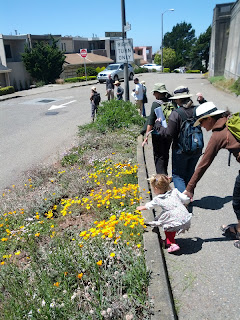When I first heard the name Green Hairstreak Corridor in connection to some gardens in the Avenues, I thought, that's so San Franciscan, and so very punk rock. Then I learned the Green Hairstreak was the name of a tiny butterfly.
Nature in the City led a recent butterfly walk from Hawk Hill to Turtle Hill, places I had never been (and I grew up in the City). We saw rare butterflies, a beautiful tiled staircase I've always wondered about, and climbed across Turtle Hill, a phenomenal "dune island" of sand, bedrock, and native plant.
Not only would I bring a kid on this hike, but visiting friends and locals like me who never happened to walk this path before.
THE GREEN HAIRSTREAK
The Green Hairstreak is not in reference to dyed hair, like I thought, but a nickel-sized green butterfly, Callophyrs rubi. Its wings are brown on top and electric green underneath, and it rests with wings shut so that only the green shows, bright emerald, trying to blend into the foliage.
Amazingly along the way, we saw the elusive Green Hairstreak---maybe five or six individuals resting, and perhaps laying eggs, on coastal buckwheat. It happened to be a sunny day, which increased our chances of seeing butterflies, according to lepidopterist Amber Hasselbring, who was on the hike. I found out later that the Green Hairstreak only flies for about a week in the spring. Lucky to see it, indeed.
SEX & GRUB
I might have this wrong, but the Green Hairstreak only has two local hosts (plants on which it lays its eggs): deer weed and coastal buckwheat, the latter a humble-looking plant planted in nooks and crannies, DPW-owned land, and parks dotting14th and 15th Avenue between Hawk Hill and Turtle Hill. The Green Hairstreak sups nectar from wild cucumber and seaside daisy, also planted in this corridor.
We wandered up 14th Avenue, a mostly treeless, concrete slab, like much of the Avenues and my own neighborhood of Vis Valley. Paul Chasen from the Green Connections group of the SF Planning Department talked about the future vision of streets as green corridors. The City has changed a lot since I was a kid in the Eighties, and though I hated change in the Nineties, I'm actually excited about what it will be like twenty years from now, when my daughter is an adult.
We passed Golden Gate Heights Park, where I believe was a great big retaining wall made of concrete. Wild cucumber grows at its base (wouldn't it be cool to cover the wall with trellis?). At Rocky Outcrop Park, at 14th and Ortega, we saw some of the oldest coastal buckwheat, according to Melanie Trellis, a site steward with Nature in the City, and Diedre Martin, who's involved with the backyard nursery network.
The walk ended at Grandview Park, which locals call Turtle Hill, my new favorite place to hike for an amazing view. According to Park & Rec, it's a "dune island" made of bedrock and 140-million year old Franciscan chert, which is essentially lots of tiny sea critters. While up top, hawks and crows bandied around in the sky, a cold wind blew, and the view was clear all the way to the Farallones.
CONSERVATION
 |
| The Green Hairstreak (Callophyrs rubi) on coastal buckwheat |
Not only would I bring a kid on this hike, but visiting friends and locals like me who never happened to walk this path before.
 |
| Buckwheat in the back |
Amazingly along the way, we saw the elusive Green Hairstreak---maybe five or six individuals resting, and perhaps laying eggs, on coastal buckwheat. It happened to be a sunny day, which increased our chances of seeing butterflies, according to lepidopterist Amber Hasselbring, who was on the hike. I found out later that the Green Hairstreak only flies for about a week in the spring. Lucky to see it, indeed.
SEX & GRUB
 |
| Spotting butterflies |
THE ROUTE
We met at 14th Avenue and Rivera Street, at the base of Hawk Hill. Hoover Middle School is right there too; apparently the kids are involved to some extent in cultivating native plants. (Right on to whomever is helping teach them to appreciate and care for their local environment!)
 |
| Rocky Outcrop Park |
At Moraga, between 15th and 16th, is an amazing staircase covered in tile mosaics. I've seen photos of this incredible project, but this was my first time here. Coupled with the Green Hairstreak corridor, the local residents are awfully lucky to have such cool things going on in their hood.
 |
| Turtle Hill, intersection of 14th &15th Avenues |
Through great human efforts towards conservation--and the tenacity of the butterfly itself--the Green Hairstreak continues to exist in San Francisco. Most of its habitat has been destroyed, obviously. Just look at the concrete slab that most of the City is, especially in the Avenues. Groups like Nature in the City and Green Connections (and many others) want species like this to survive. It's incredible to think that what we plant in our gardens makes a difference.
Native Plant Nurseries:
Relevant Websites:
- The Green Hairstreak Project: SF Natural History Series
- "Gardening for Wildlife" -- Nature in the City
- 16th Avenue Tiled Staircase (Moraga Street b/t 16th & 15th Avenues)
- Art-Ecology (Lepidopterist Amber Hasselbring's website)
- Green Connections (San Francisco Planning Department)
Starting Point (14th & Rivera, at the base of Hawk Hill):
View Larger Map
GREEN HAIRSTREAK WORKDAY
Meet at 14th and Pacheco on the 3rd Saturday of every month from 10 am - 1 pm Bringing your own tools & gloves is welcomed! Email stewards@natureinthecity.org if you have questions. |

Thanks nice post!
ReplyDelete